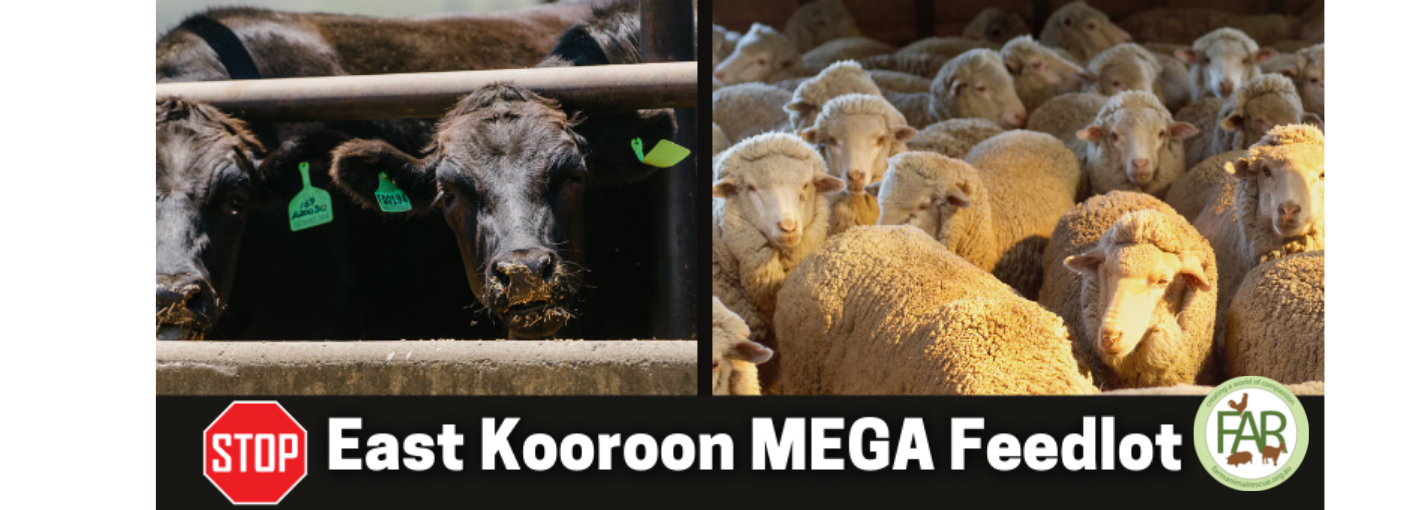
An application for a new 10,000 sheep and 50,000 cow mega feedlot next to the Ula Ula State Forest has been lodged with the Balonne Shire Council. If approved, this feedlot will have a detrimental impact on the environment, the local ecosystem, as well as resulting in the confinement and suffering (and ultimately, the slaughter) of tens of thousands of animals every year.
You can help challenge this feedlot proposal.
The Balonne Shire Council is accepting public submissions regarding this application until 07/07/21. Please speak up for the thousands of sheep and cows as well as the impact on wildlife that will be affected by this factory farm.
We have included an email template below which is ready to copy and send. You may also like to edit to include your own respectful opinions and concerns. Simply copy the email - click the button below for the Balonne Shire Council email address.
Sample email template ...
Dear Balonne Shire Council,
Objection re: East Kooroon Feedlot development proposal (MCU193)
Thank you for this opportunity to present a personal submission regarding the Development Application for a 10,000 standard sheep units (SSU) and 50,000 standard cattle units (SCU) feedlot at 315 Trackers Crossing Road in St George.
In short, I strongly object to the application. The reasons for my objection are particularised below.
1. Water Usage has been underestimated.
The applicant has stated that they have a water allowance of 780 ML of surface water, drawn from the Moonie River and overland flow, and that this is “adequate to service the needs of the development at full capacity”.
The main water requirement for the proposed feedlot will be the drinking water of the cattle. The applicant has estimated that the average daily intake of water is 36.5L per head per day, equating to 718ML per year at full capacity.
Given the warm climate of the region, especially during summer months, this water allocation seems to be extremely under estimated. According to the website, Future Beef, “In northern Australia hot summer temperatures significantly influence daily intake of water. A rise of 10ºC (e.g. from 25ºC to 35ºC) can almost double daily consumption, particularly if there is high humidity as well. For example, at 25ºC dry cows may drink 40L but this will increase to 70L at 32ºC, and higher during very hot conditions.”
Future Beef estimates that, in summer months, beef cattle will drink up to 70L of water per day. Given this, it’s likely that the water consumption at full capacity could be almost double the estimated amount, especially through summer months.
This water will be drawn from the Moonie River, an important water source for wildlife, aquatic life and for land owners. At a time when the region and the state has been drought declared for years, we need to be protecting this precious resource.
2. This development will threaten the health and biodiversity of the local ecosystem.
Intensive animal factory farms pose significant negative environmental risks and impacts to our unique rural landscapes. Indeed, intensive industrial animal farms — such as the application under discussion — have been an ongoing source and cause of environmental damage. Such instances have included toxic run off, soil and groundwater contamination, explosions and fires.
Impacts upon biodiversity often result in large scale animal suffering and death, serious biosecurity risks, and associated impacts on human health and community welfare, other landowners, and potentially under-threat native wildlife.
I submit that the proposed site is unsuitable for a number of reasons including, but not limited to, the following:
- This feedlot is in close proximity to the Ula Ula State Forest, and there are significant areas of native vegetation close to the proposed feedlot site. This poses significant risks to the local flora and fauna living within this ecosystem who will be impacted by noise & dust both during the construction phase and during the ongoing operations of the feedlot.
- We must be doing everything we can to protect our local flora and fauna, and this development will put the local ecosystem at an unacceptable level of risk.
3. Unacceptable risk to Moonie River and associated ecosystem.
This property is bordered by the Moonie River, part of the Murray Darling Basin. The Moonie catchment is ecologically significant as it flows through the endangered southern brigalow belt, which contains remnants of brigalow forests, poplar box, wilga and white cypress pine. The Moonie River system has more than 100 floodplain wetlands, many of which support bird breeding, and includes high biodiversity and unique in-stream systems.
The catchment provides habitat to several protected species of birds, including the Australian painted snipe and the freckled duck, and contains threatened and endangered plant species and three endangered vegetation communities.
As well as our concerns about the volume of water that will be taken from the Moonie River to service this development, the development also has land on the alluvial plains adjoining the Moonie River where part of the effluent and solid waste utilisation areas are subject to inundation in high rainfall.
This would result in organic and mineralised manure constituents flowing into the Moonie River, resulting in a significant ecological hazard and damage to the water system, causing pollution, death of aquatic animals and potentially impacting human health. This is not a risk the council should take.
4. Waste management and associated pollution, groundwater pollution, emissions and vermin.
There are significant concerns regarding the dispersal of the waste, storage, pollution and smell. On average, a cow produces 20kg of solid waste daily. This equals over 1 tonne of manure per day - a staggering amount. This will undoubtedly attract vermin such as flies and will have an extremely negative impact on biodiversity.
In addition to the manure that will be produced, the application also predicts that, on average, 30 tonnes of cow carcasses will be added to the compost pile each year. It would be foolish to assume that this will not result in the attraction of flies and other vermin and impact the biosecurity of the area.
There are specific performance objectives outlined in the EP Act and subordinate legislation that are required to be met when constructing and operating a development, one of which states that the ‘development must not increase the number or variety of the following animals:
* Flies.
This development therefore may constitute a breach of the Act.
5. Summary and conclusion: The detrimental impacts of intensive, 'factory' farming on animal welfare, the environment — and people
Globally, experts agree that industrial, intensive farming — such as that proposed in the application — pose a real and serious threat to public health and safety, and I urge that this threat be taken into urgent consideration by Council.
Approving intensive animal agriculture applications directly contributes to the loss of critical Aboriginal heritage, rapid decline in biodiversity, soil erosion and contamination, lack of surface and groundwater security, pollution including emissions caused by animal agriculture, and appalling animal cruelty — all of which are broadly held and valid public concerns.
Additionally, the peaceful 'country life' that community members value and seek is directly threatened by the development of intensive farming facilities that pose a risk to the environment, animal welfare, and — in a less tangible but equally important sense — the 'liveability' of our regional communities. There are very few intensive farms in the Balonne Shire region, and approving an enormous development such as this could set a dangerous precedent.
Rather than allowing damaging, intensive animal agriculture to flourish in the region, I hope that Balonne Shire Council will instead look at encouraging and approving sustainable ventures that work in harmony with the environment and align with social expectations, enrich the region and thereby improve the health and wellbeing of all community members.
Thank you for reading and considering my objection to MCU193. For the reasons outlined above, I request that Balonne Shire Council, as consent authority, refuse the application for an intensive 10,000 standard sheep unit and 50,000 standard cattle unit factory farm feedlot.
Sincerely, (your name)

